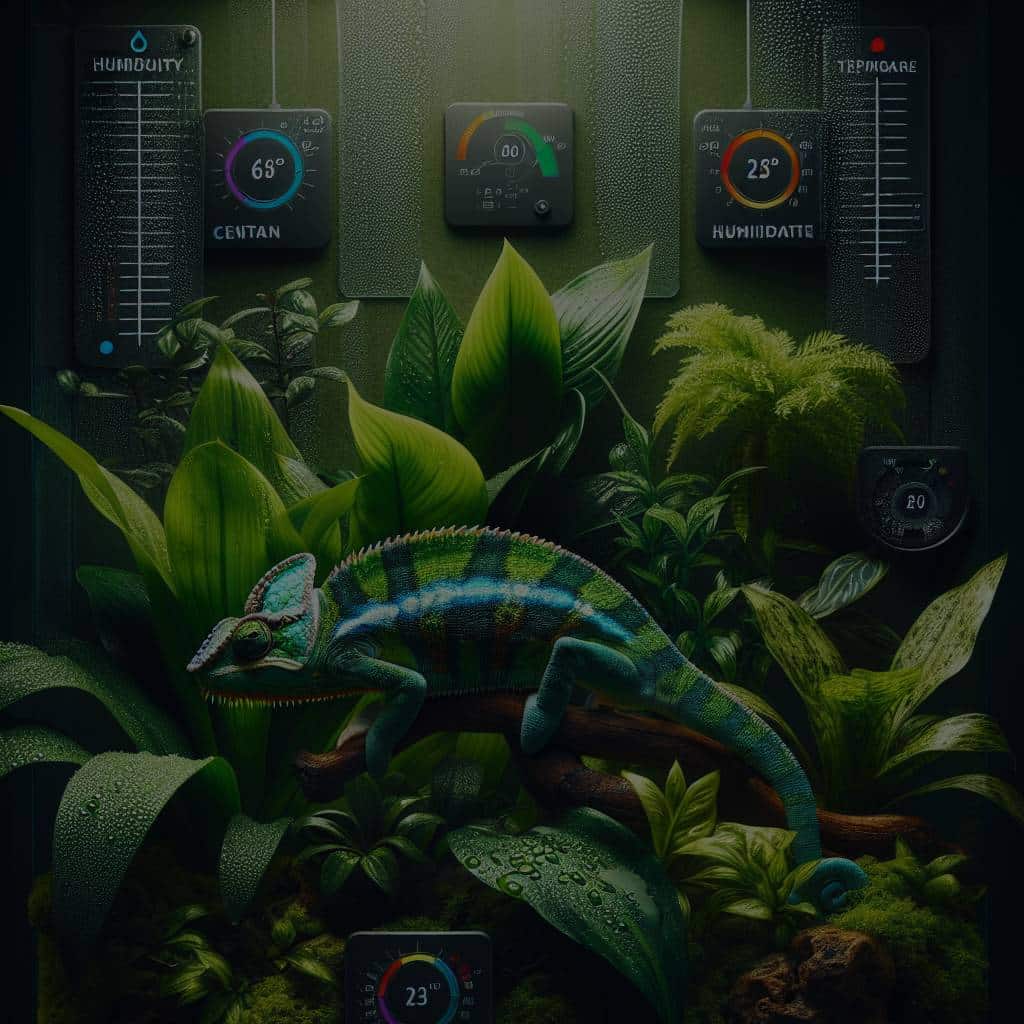What Are the Ideal Humidity Levels for a Pet Chameleon’s Terrarium?

Chameleons, with their unique ability to change color and their distinctive, slow-motion strut, make fascinating pets. However, these exotic reptiles also demand specific environmental conditions to stay healthy. Among the necessary requirements, the most crucial is perhaps the right humidity level within their enclosure. In this article, we will guide you on how to ensure that you are providing the ideal humidity levels for your pet chameleon’s terrarium.
Understanding the Natural Habitat of Chameleons
Before delving into the specific humidity needs of a chameleon, you should take time to understand the natural habitat of this reptile. Chameleons are predominantly found in the jungles and rainforests of Africa and Madagascar, where humidity levels are high.
Also to see : How to Safely Introduce a New Bearded Dragon to Your Existing Reptile Collection?
In these humid environments, chameleons have adapted to regulate their body temperature and hydration levels by using their surroundings. They rely on the moisture from the dew and raindrops on leaves to drink and regulate their body heat. It is therefore crucial to mimic this environment inside their terrarium as closely as possible to ensure their well-being.
Ideal Humidity Levels for a Chameleon’s Terrarium
The optimal humidity levels for a chameleon’s terrarium will depend on the specific species. Most chameleons require high humidity levels, typically between 50% and 70%, but some, like the Veiled Chameleon, need humidity levels closer to 80%.
Also read : What’s the Correct Dosage of Probiotics for a Dog Suffering from Chronic Digestive Issues?
Maintaining the right humidity levels inside your chameleon’s cage is crucial to its health. Too low humidity can cause dehydration and shedding problems, while too high humidity can create a breeding ground for bacteria and mold, leading to respiratory infections.
To accurately measure the humidity level inside the cage, you can use a digital hygrometer. These devices are inexpensive and easy to use, providing you with an instant reading. Ideally, you should monitor the humidity levels daily to ensure they remain within the required range.
How to Maintain the Right Humidity Level
Achieving and maintaining the right humidity level in a chameleon’s enclosure involves attention to water, heat, temperature, light, and substrate.
Using a misting system can help maintain the proper humidity levels. Misting should be done at least twice a day, ideally early in the morning and late in the evening, to mimic a chameleon’s natural conditions. Adding live plants to the enclosure can also help maintain humidity and provide the chameleon with a more natural environment.
The heat and temperature of the cage are also critical factors in maintaining humidity. Chameleons require a basking spot with a temperature of around 85 degrees Fahrenheit. On the other hand, the cooler part of the cage should be around 70 degrees Fahrenheit. A steady heat source can help maintain these temperature levels, which in turn will help to manage the humidity levels.
UVB light is also crucial for chameleons. It helps them metabolize calcium and stay healthy. Make sure the cage is well lit with a UVB bulb for about 12 hours a day.
The substrate or bedding can also affect the humidity level in the cage. Using a substrate that retains water can help maintain humidity levels. Coconut fiber and moss are both excellent choices.
Regular Monitoring and Adjustment
Remember, maintaining the ideal humidity levels for your pet chameleon’s terrarium is not a one-time task. It requires daily monitoring and regular adjustments.
You will need to monitor the humidity levels, temperature, and the general condition of the cage regularly. Also, make sure the water supply is clean and the plants are in a healthy state. You may need to adjust the frequency of misting or change the substrate depending on the readings from the hygrometer.
Chameleons are sensitive to changes in their environment. Therefore, you should keep their environment as stable as possible. Understand that changes should be made gradually to avoid causing stress to your chameleon.
Final Thoughts
Chameleons are fascinating and intriguing creatures that can make wonderful pets. However, they have specific and somewhat complex needs. Providing the right humidity levels in their terrarium is among those imperative needs. By understanding these requirements, monitoring the conditions daily, and making necessary adjustments, you can help your pet chameleon live a long, happy, and healthy life.
Incorporating Suitable Accessories to Maintain Humidity Levels
Maintaining the ideal humidity levels for your pet chameleon extends beyond the natural elements like water and live plants. It also involves incorporating suitable accessories like screen cages, an exo terra, or a zoo med into your chameleon’s enclosure.
A screen cage, typically recommended for adult chameleons, allows for excellent airflow and can help in regulating humidity levels. It provides a good ventilation system that prevents the accumulation of moisture and the proliferation of bacteria or mold. On the other hand, a glass or acrylic enclosure, like the exo terra or the zoo med, can be a good option for baby or juvenile chameleons, as they tend to require higher humidity levels which are easier to maintain in these types of enclosures.
The size of the enclosure is also critical. A small enclosure might be easier to keep humid but can limit the chameleon’s movement. On the other hand, a large enclosure can provide ample space but might require additional effort to maintain the necessary humidity level. A 50-gallon reptile terrarium can be an excellent starting point for a pet chameleon.
Moreover, including a basking branch in your pet chameleon’s enclosure is beneficial. It not only gives the chameleon a place to rest and bask but also aids in maintaining the right temperature gradient. Position the basking branch such that it is close enough to the light source for the chameleon to warm up but far enough to prevent overheating. The basking spot should maintain a temperature of around 85 degrees Fahrenheit, while the cooler end of the terrarium should be around 70 degrees Fahrenheit.
Seasonal Adjustments for Your Pet Chameleon
Chameleons, like many other animals, are affected by seasonal changes. In their natural habitat, they go through a wet season and a dry season each year. Veiled chameleons, for example, come from Yemen, where the wet season is characterized by high humidity levels due to frequent thunderstorms. Conversely, the dry season sees a significant decrease in these levels.
To mimic these seasonal changes, you will need to adjust the humidity level in your pet chameleon’s enclosure according to the time of year. In the dry season, you can reduce the frequency of misting and maintain humidity levels slightly lower than usual. Conversely, during the wet season, mist more frequently to simulate the increased rainfall.
However, it is crucial to remember that these adjustments should be gradual and monitored closely to avoid causing stress to your pet chameleon. A care sheet can be used to keep track of the changes made and the corresponding responses of the chameleon.
Conclusion
Providing the ideal humidity levels for a pet chameleon’s terrarium involves understanding their natural habitat, meeting their specific needs, and making appropriate adjustments. The overall goal is to recreate their natural environment as closely as possible within the enclosure. This involves using a variety of tools and strategies, from opting for the right type of cage to incorporating live plants, using a misting system, and making seasonal adjustments.
Remember, chameleons are unique and sensitive creatures. They require daily care and monitoring to ensure they are living under optimal conditions. With careful observation and a commitment to their well-being, you can ensure your pet chameleon will thrive and live a long, healthy life.
